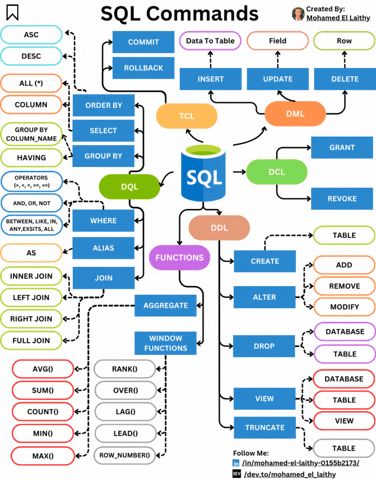Summary of All SQL Commands In One Animated Diagram
SQL is the language that powers data management, and mastering its core commands is essential for anyone working with databases. Let’s break them down into five main categories: ✅ DQL (Data Query Language): Retrieve data from databases using commands like: SELECT — Extract specific data from tables. WHERE — Filter records based on conditions. JOIN — Combine rows from multiple tables. ✅ DML (Data Manipulation Language): Modify data with commands such as: INSERT — Add new records. UPDATE — Modify existing records. DELETE — Remove records. ✅ DDL (Data Definition Language): Define and manage database structures: CREATE — Add new tables or databases. ALTER — Modify table structures. DROP — Remove tables or databases. ✅ DCL (Data Control Language): Control access to the database with: GRANT — Provide specific privileges to users. REVOKE — Remove previously granted privileges. ✅ TCL (Transaction Control Language): Manage transactions to maintain data integrity: COMMIT — Save changes permanently. ROLLBACK — Undo changes if an error occurs. Mastering these commands gives you the power to handle data efficiently, ensuring your applications run smoothly and securely.

SQL is the language that powers data management, and mastering its core commands is essential for anyone working with databases. Let’s break them down into five main categories:
✅ DQL (Data Query Language): Retrieve data from databases using commands like:
-
SELECT— Extract specific data from tables. -
WHERE— Filter records based on conditions. -
JOIN— Combine rows from multiple tables.
✅ DML (Data Manipulation Language): Modify data with commands such as:
-
INSERT— Add new records. -
UPDATE— Modify existing records. -
DELETE— Remove records.
✅ DDL (Data Definition Language): Define and manage database structures:
-
CREATE— Add new tables or databases. -
ALTER— Modify table structures. -
DROP— Remove tables or databases.
✅ DCL (Data Control Language): Control access to the database with:
-
GRANT— Provide specific privileges to users. -
REVOKE— Remove previously granted privileges.
✅ TCL (Transaction Control Language): Manage transactions to maintain data integrity:
-
COMMIT— Save changes permanently. -
ROLLBACK— Undo changes if an error occurs.
Mastering these commands gives you the power to handle data efficiently, ensuring your applications run smoothly and securely.










































































































































































![[The AI Show Episode 142]: ChatGPT’s New Image Generator, Studio Ghibli Craze and Backlash, Gemini 2.5, OpenAI Academy, 4o Updates, Vibe Marketing & xAI Acquires X](https://www.marketingaiinstitute.com/hubfs/ep%20142%20cover.png)



























































































































![[FREE EBOOKS] The Kubernetes Bible, The Ultimate Linux Shell Scripting Guide & Four More Best Selling Titles](https://www.javacodegeeks.com/wp-content/uploads/2012/12/jcg-logo.jpg)



![From drop-out to software architect with Jason Lengstorf [Podcast #167]](https://cdn.hashnode.com/res/hashnode/image/upload/v1743796461357/f3d19cd7-e6f5-4d7c-8bfc-eb974bc8da68.png?#)






































































































.png?#)




.jpg?#)
































_Christophe_Coat_Alamy.jpg?#)







































































































![Rapidus in Talks With Apple as It Accelerates Toward 2nm Chip Production [Report]](https://www.iclarified.com/images/news/96937/96937/96937-640.jpg)









































































































































